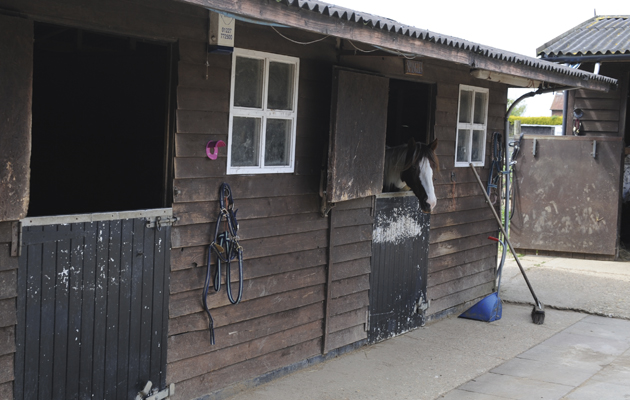Even without the coronavirus, times have been tough for riding schools, livery yards and competition centres. H&H speaks to centres and businesspeople to find out what could be done to help
A CHANGE in perspective from both employers and clients could be key to ensuring equestrian businesses stay financially viable in challenging times.
H&H has reported on the many and varied impacts of Government policy, such as business rates and minimum wage increases, rising insurance premiums and the industry’s need to remain relevant to clients with a wide choice of leisure activities to choose from – even without the effects of the coronavirus.
But another obstacle to being able to make a profit could be clients’ views of the sector.
{"content":"PHA+4oCcSSBmZWVsIHF1aXRlIHN0cm9uZ2x5IHRoYXQgcGVvcGxlIG5lZWQgdG8gYmUgcmVhbGlzdGljIGFib3V0IHdoYXQgaXQgY29zdHMgdG8ga2VlcCBhIGhvcnNlLOKAnSBUdWxsaXMgTWF0c29uIG9mIFN0YWxsaW9uIEFJIFNlcnZpY2VzLCBhbHNvIHByZXNpZGVudCBvZiB0aGUgRXF1ZXN0cmlhbiBFbXBsb3llcnMgQXNzb2NpYXRpb24gKEVFQSksIHRvbGQgPGVtPkgmYW1wO0guPC9lbT48L3A+CjxwPuKAnFdhZ2VzIGhhdmUgdG8gZ28gdXAsIHByaWNlcyBvZiBmZWVkIGFuZCBpbnN1cmFuY2UgZ28gdXAsIGJ1dCBsaXZlcnkgZG9lc27igJl0OyBwZW9wbGUgbmVlZCBhIHJlYWxpdHkgY2hlY2sgYWJvdXQgdGhlIGNvc3RzLuKAnTwvcD4KPHA+PGRpdiBjbGFzcz0iYWQtY29udGFpbmVyIGFkLWNvbnRhaW5lci0tbW9iaWxlIj48ZGl2IGlkPSJwb3N0LWlubGluZS0yIiBjbGFzcz0iaXBjLWFkdmVydCI+PC9kaXY+PC9kaXY+PHNlY3Rpb24gaWQ9ImVtYmVkX2NvZGUtMzEiIGNsYXNzPSJoaWRkZW4tbWQgaGlkZGVuLWxnIHMtY29udGFpbmVyIHN0aWNreS1hbmNob3IgaGlkZS13aWRnZXQtdGl0bGUgd2lkZ2V0X2VtYmVkX2NvZGUgcHJlbWl1bV9pbmxpbmVfMiI+PHNlY3Rpb24gY2xhc3M9InMtY29udGFpbmVyIGxpc3RpbmctLXNpbmdsZSBsaXN0aW5nLS1zaW5nbGUtc2hhcmV0aHJvdWdoIGltYWdlLWFzcGVjdC1sYW5kc2NhcGUgZGVmYXVsdCBzaGFyZXRocm91Z2gtYWQgc2hhcmV0aHJvdWdoLWFkLWhpZGRlbiI+DQogIDxkaXYgY2xhc3M9InMtY29udGFpbmVyX19pbm5lciI+DQogICAgPHVsPg0KICAgICAgPGxpIGlkPSJuYXRpdmUtY29udGVudC1tb2JpbGUiIGNsYXNzPSJsaXN0aW5nLWl0ZW0iPg0KICAgICAgPC9saT4NCiAgICA8L3VsPg0KICA8L2Rpdj4NCjwvc2VjdGlvbj48L3NlY3Rpb24+PC9wPgo8cD5UdWxsaXMgY2l0ZWQgdGhlIGV2ZXJ5ZGF5IGNvc3RzIDxhIGhyZWY9Imh0dHBzOi8vd3d3LmhvcnNlYW5kaG91bmQuY28udWsvdGFnL2xpdmVyeS15YXJkcyI+bGl2ZXJ5IHlhcmQ8L2E+IG93bmVycyBtdXN0IHRha2UgaW50byBhY2NvdW50IHdoZW4gc2V0dGluZyBwcmljZXMsIHN1Y2ggYXMgc3RhZmYgdGltZSwgZmVlZCBhbmQgZm9yYWdlLCB3aGljaCBjb3VsZCBuZWFyIMKjMjAgcGVyIGRheSBmb3IgZnVsbCBsaXZlcnkuIEJ1dCBvbiB0b3Agb2YgdGhhdCwgeWFyZCBvd25lcnMgaGF2ZSB0byB0YWtlIGludG8gYWNjb3VudCBmYWN0b3JzIG5vdCBvbmx5IGluY2x1ZGluZyBidXNpbmVzcyByYXRlcyBhbmQgaW5zdXJhbmNlLCBidXQgYWxzbyBkZXByZWNpYXRpb24gaW4gdmFsdWUgb2YgYnVpbGRpbmdzLCBhbmQgdGhlIGNvc3Qgb2YgbWFpbnRlbmFuY2UuPC9wPgo8cD7igJxZb3UgaGF2ZSB0byBiZSByZWFsaXN0aWMgYWJvdXQgd2hhdCBpdCBjb3N0cywgYnV0IHlvdSBoYXZlIHRvIG1ha2UgYSBwcm9maXQgdG8gc3Vydml2ZSzigJ0gaGUgc2FpZCwgYWRkaW5nIHRoYXQgYSBjb21tb24gYXR0aXR1ZGUgaW4gdGhlIFVLIGVxdWVzdHJpYW4gd29ybGQgaXMgdGhhdCBwZW9wbGUgZG8gdGhlIGpvYiBmb3IgdGhlIGxvdmUgb2YgaXQ7IHNvIG5vdCBvbmx5IGlzIG1ha2luZyBhIHByb2ZpdCBub3QgYWx3YXlzIHNlZW4gYXMgYW4gaW50ZWdyYWwgcGFydCBvZiBydW5uaW5nIHRoZSBidXNpbmVzcywgc29tZSBvd25lcnMgYXJlIG1vcmUgZXF1ZXN0cmlhbi0gdGhhbiBidXNpbmVzcy1taW5kZWQuPC9wPgo8cD7igJxJdCBtYXkgYmUgYSBzbGlnaHRseSBzdXJ2aXZhbCBvZiB0aGUgZml0dGVzdCB0aGluZywgd2hlcmUgdGhvc2Ugd2hvIGhhdmUgc3RlYWR5IHByaWNlIGluY3JlYXNlcyBldmVyeSB5ZWFyIHdpbGwgY2Fycnkgb24gYnV0IG90aGVycyBmYWxsIGJlaGluZCBhbmQgc3VkZGVubHkgaGF2ZSB0byBwdXQgcHJpY2VzIHVwIGJ5IGEgbG90IG1vcmUsIGFuZCBvd25lcnMgd2lsbCBzYXkgdGhleSBjYW7igJl0IGFmZm9yZCB0byBwYXkgaXQs4oCdIGhlIHNhaWQuPC9wPgo8ZGl2IGNsYXNzPSJhZC1jb250YWluZXIgYWQtY29udGFpbmVyLS1tb2JpbGUiPjxkaXYgaWQ9InBvc3QtaW5saW5lLTMiIGNsYXNzPSJpcGMtYWR2ZXJ0Ij48L2Rpdj48L2Rpdj4KPGgzPlVuZGVyY3V0dGluZzwvaDM+CjxwPlRVTExJUyBzYWlkIHRoZSBpc3N1ZSBvZiBsb2NhbCB5YXJkcyB1bmRlcmN1dHRpbmcgZWFjaCBvdGhlciwgYnkgY2hhcmdpbmcgcHJpY2VzIHRoYXQgbWVhbiB0aGV5IGNhbm5vdCBtYWtlIGEgcHJvZml0LCB3YXMgcmFpc2VkIGF0IHRoZSBFRUEgY29uZmVyZW5jZSBsYXN0IHllYXIsIGFzIHdhcyB0aGUgcG9zc2liaWxpdHkgb2YgdHJ5aW5nIHRvIHNldCBhIGNhcCBzbyBhbGwgeWFyZHMgY2FuIHN1cnZpdmUuPC9wPgo8cD5BdXJvcmEgRWFzdHdvb2QsIHdobyBydW5zIGEgbGl2ZXJ5IHlhcmQgZnJvbSBoZXIgaG9tZSBpbiBIYW1wc2hpcmUsIHRvbGQgPGVtPkgmYW1wO0g8L2VtPiBzaGUgaGFzIHN1ZmZlcmVkIGZyb20gb3RoZXJzIG9mZmVyaW5nIGNoZWFwZXIgbGl2ZXJ5LiBTaGUgaGFkIHRvIHB1dCBoZXIgcHJpY2VzIHVwLCBhcyBzaGUgd2FzIGxvc2luZyBtb25leSBvbiBoZXIgYnVzaW5lc3MuPC9wPgo8ZGl2IGNsYXNzPSJhZC1jb250YWluZXIgYWQtY29udGFpbmVyLS1tb2JpbGUiPjxkaXYgaWQ9InBvc3QtaW5saW5lLTQiIGNsYXNzPSJpcGMtYWR2ZXJ0Ij48L2Rpdj48L2Rpdj4KPHA+4oCcQWxsIHRoZSBsb2NhbCB5YXJkcyBjaGFyZ2VkIHJvdWdobHkgdGhlIHNhbWUgYXMgSSBkaWQgYnV0IEkgY291bGQgbm8gbG9uZ2VyIG9wZXJhdGUgb24gdGhhdCBiYXNpcyzigJ0gc2hlIHNhaWQuIOKAnEkgY291bGRu4oCZdCBqdXN0aWZ5IG1ha2luZyBhIGxvc3MgYW55IG1vcmUu4oCdPC9wPgo8cD5NcyBFYXN0d29vZCBhZ3JlZWQgd2l0aCBUdWxsaXMgdGhhdCBzb21lIGNsaWVudHMgZG8gbm90IHRha2UgaW50byBhY2NvdW50IGFsbCB0aGUgY29zdHM7IGV2ZW4gcnVubmluZyBhIHRyYWN0b3IgZm9yIGFuIGhvdXIgdG8gbGV2ZWwgdGhlIGFyZW5hIG9yIG1haW50YWluIHRoZSBmaWVsZHMgY29zdHMgwqMyNS48L3A+CjxkaXYgY2xhc3M9ImFkLWNvbnRhaW5lciBhZC1jb250YWluZXItLW1vYmlsZSI+PGRpdiBpZD0icG9zdC1pbmxpbmUtNSIgY2xhc3M9ImlwYy1hZHZlcnQiPjwvZGl2PjwvZGl2Pgo8cD7igJxUaGVyZeKAmXMgYW4gb2RkIHByZXNzdXJlIG9yIGFjY2VwdGFuY2UgaW4gdGhlIGhvcnNlIHdvcmxkIHRoYXQgeW91IHNob3VsZG7igJl0IGV4cGVjdCB0byBlYXJuIG1vbmV5IGZyb20gd29ya2luZyB3aXRoIGhvcnNlcywgYnV0IHRoYXTigJlzIHdyb25nLOKAnSBzaGUgc2FpZC48L3A+CjxwPuKAnElmIHlvdSBwdXQgeW91ciBkb2cgaW4gZGF5Y2FyZSwgcGVvcGxlIHNlZW0gdG8gYmUgcHJlcGFyZWQgdG8gcGF5IMKjMjUgb3IgbW9yZSwgYSBjaGlsZCBpbiBudXJzZXJ5IG1pZ2h0IGJlIMKjNjUgdG8gwqMxMDAgcGVyIGRheSwgd2l0aCB0aGUgc2FtZSBzdGFmZi10by1jaGlsZCByYXRpbyBhcyBJIGhhdmUgZm9yIGhvcnNlcywgZm9yIGEgdGhpcmQgb2YgdGhlIHRpbWUgSSBsb29rIGFmdGVyIGhvcnNlcyBoZXJlIOKAkyBhbmQgYSBzbWFsbCBjaGlsZCBkb2VzbuKAmXQgZWF0IGFzIG11Y2ggYXMgYSAxN2hoIHdhcm1ibG9vZC48L3A+CjxwPuKAnEkgdGhpbmsgYXMgYW4gaW5kdXN0cnksIGFsbCB5YXJkcyBuZWVkIHRvIGxvb2sgYXQgdGhlaXIgY29zdHMgYW5kIHNldCBhIGZhaXIgcHJvZml0IG1hcmdpbiBmb3IgdGhlaXIgd29yayBhbmQgY2FyZS7igJ08L3A+CjxwPkhlbGVuIFdpbGxpYW1zLCBmaW5hbmNlIGRpcmVjdG9yIG9mIHRoZSBXZWxsaW5ndG9uIEVzdGF0ZSBpbiBIYW1wc2hpcmUsIHdoaWNoIGluY2x1ZGVzIFdlbGxpbmd0b24gUmlkaW5nIGVxdWVzdHJpYW4gY2VudHJlLCB0b2xkIDxlbT5IJmFtcDtIPC9lbT4gc3RhZmZpbmcgY29zdHMgYXJlIHRoZSBiaWdnZXN0IGNoYWxsZW5nZSwgYXMgaXQgaXMgc3VjaCBhIGxhYm91ci1pbnRlbnNpdmUgYnVzaW5lc3MuPC9wPgo8cD7igJxUaGlzIHllYXIgaGFzIHNob3duIGp1c3QgaG93IG11Y2ggYXMgd2UgY2Fu4oCZdCBjdXQgdGhvc2UgY29zdHMs4oCdIHNoZSBzYWlkLiDigJxJdOKAmXMgYmVlbiByZWFsbHkgaGFyZCBhbmQgaWYgd2UgaGFkbuKAmXQgaGFkIHRoZSBzdXBwb3J0IG9mIHRoZSBlc3RhdGUsIEnigJltIG5vdCBzdXJlIFdlbGxpbmd0b24gUmlkaW5nIHdvdWxkIGhhdmUgc3Vydml2ZWQu4oCdPC9wPgo8cD5NcyBXaWxsaWFtcyBhZ3JlZXMgZXF1ZXN0cmlhbiBjZW50cmVz4oCZIGNsaWVudHMgbXVzdCBiZSByZWFsaXN0aWMuPC9wPgo8cD7igJxJ4oCZdmUgZ290IG15IGhvcnNlIGJlY2F1c2UgSSBjYW4gYWZmb3JkIHRvIGtlZXAgaGVyIGJ1dCBJ4oCZbSBhd2FyZSBzaGXigJlzIGEgbHV4dXJ5LOKAnSBzaGUgc2FpZC4g4oCcSWYgSSBjb3VsZG7igJl0IGFmZm9yZCBoZXIsIEkgY291bGRu4oCZdCBoYXZlIGhlcjsgaXTigJlzIG5vdCB1cCB0byB3aGVyZSBJIGtlZXAgaGVyIHRvIGZ1bmQgaGVyIGZvciBtZS48L3A+CjxwPuKAnFRoZXJl4oCZcyBhIHNlbnNlIHRoYXQgaXTigJlzIGFuIGVudGl0bGVtZW50LCBoYXZpbmcgYSBob3JzZSwgYnV0IHdl4oCZcmUgYSBidXNpbmVzcyBhbmQgd2UgaGF2ZSB0byBjaGFyZ2UgZW5vdWdoIHRvIGNvdmVyIGNvc3RzLiBXZSBjaGFyZ2UgwqMyNDkgYSB3ZWVrIGZvciBmdWxsIGxpdmVyeSBhbmQgd2UgZG9u4oCZdCBtYWtlIG1vbmV5IG9uIHRoYXQu4oCdPC9wPgo8cD5NcyBXaWxsaWFtcyBzYXlzIFdlbGxpbmd0b24gb2ZmZXJzIGRpZmZlcmVudCBsaXZlcnkgcGFja2FnZXMsIHN1Y2ggYXMgdXNpbmcgaG9yc2VzIGluIGxlc3NvbnMsIHRvIHRyeSB0byBtYWtlIGl0IG1vcmUgYWZmb3JkYWJsZSBidXQgYWxzbyB2aWFibGUuPC9wPgo8cD7igJxJdOKAmXMgYSB0b3VnaCBidXNpbmVzcyB0byBiZSBpbiwgZXNwZWNpYWxseSBub3cs4oCdIHNoZSBzYWlkLiDigJxZb3UgaGF2ZSB0byBsb3ZlIHRoZSBqb2IsIGJ1dCBpdCBhbHNvIGhhcyB0byBiZSBjb21tZXJjaWFsbHkgdmlhYmxlLuKAnTwvcD4KPHA+QSA8YSBocmVmPSJodHRwczovL3d3dy5ob3JzZWFuZGhvdW5kLmNvLnVrL3RhZy9yaWRpbmctc2Nob29scyI+cmlkaW5nIHNjaG9vbDwvYT4gb3duZXIgd2hvIGRpZCBub3Qgd2FudCB0byBiZSBuYW1lZCB0b2xkIDxlbT5IJmFtcDtIPC9lbT4gaGUgc2hvdWxkIGNoYXJnZSBtb3JlIGZvciBsZXNzb25zLCBidXQgaWYgaGUgZG9lcywgaGUgZmVlbHMgY2xpZW50cyB3aWxsIGdvIHNvbWV3aGVyZSBjaGVhcGVyLjwvcD4KPHA+4oCcQWxsIGNlbnRyZXMgYXJlIHN0cnVnZ2xpbmcsIGluIG15IHZpZXcs4oCdIGhlIHNhaWQuIOKAnFdlIGxvb2tlZCBhdCBidXlpbmcgc29tZSBvdGhlcnMgYW5kIHN0YXJ0aW5nIGEgY2hhaW4sIGJ1dCB0aGUgZmlndXJlcyBtYWRlIGF3ZnVsIHJlYWRpbmcuIFlvdeKAmWQgaGF2ZSB0byBpbnZlc3Qgc28gbXVjaCBpbnRvIHRoZW0gYnV0IHRoZXJl4oCZcyBubyBjaGFuY2Ugb2YgZ2V0dGluZyB0aGF0IGJhY2suPC9wPgo8cD7igJxUaGlzIGlzIHRoZSBiaXR0ZXIgcGlsbCBwZW9wbGUgYXJlIHNlZWluZyB3aGVuIHRoZXkgdHJ5IHRvIHJldGlyZSDigJMgdGhlbiBsYW5kIGFnZW50cyBhcHBlYXIsIHNheWluZyB0aGUgYnVzaW5lc3MgaXNu4oCZdCB3b3J0aCBhbnl0aGluZywgYnV0IHRoZXnigJlsbCBrbm9jayBpdCBkb3duIGFuZCBidWlsZCBob3VzZXM7IHRoYXTigJlzIG9uZSByZWFzb24gcmlkaW5nIHNjaG9vbHMgYXJlIGRpc2FwcGVhcmluZy4gV2UgZ2V0IHBlb3BsZSBoZXJlIHByb2JhYmx5IGV2ZXJ5IG1vbnRoLCBzcGVjdWxhdGl2ZWx5LCB0YWxraW5nIGFib3V0IGJ1aWxkaW5nIGhvdXNlcyBoZXJlLuKAnTwvcD4KPHA+VGhlIG93bmVyIHNhaWQgaGlzIHNjaG9vbCBnaXZlcyBzb21lIDEyLDAwMCBsZXNzb25zIGV2ZXJ5IHllYXIsIGFuZCBoZSBzdHJ1Z2dsZXMgdG8gYmVsaWV2ZSB0aGF0IHRoaXMgZG9lcyBub3QgbWFrZSBhIHByb2ZpdC48L3A+CjxwPuKAnEl0IG1heSBiZSB0aGVyZSBhcmUgdG9vIG1hbnkgcmlkaW5nIHNjaG9vbHMs4oCdIGhlIHNhaWQuIOKAnE1heWJlIHdl4oCZbGwgZW5kIHVwIHdpdGggZmV3ZXIsIGJpZ2dlciwgY2VudHJlcyBldmVudHVhbGx5LCBhbmQgdGhleeKAmWxsIGNoYXJnZSBtb3JlOyBidXQgdGhhdCB3aWxsIG1ha2UgdXMgYmFjayBpbnRvIGFuIGVsaXRlIHNwb3J0IGFnYWluLCB3aGljaCB3b3VsZCBiZSBhIHJlYWwgc2hhbWUuPC9wPgo8cD7igJxJIHRoaW5rIGNlbnRyZXMgd2lsbCBoYXZlIHRvIGV2b2x2ZSwgbWF5YmUgb2ZmZXJpbmcgY29mZmVlIHNob3BzIGFuZCBsb3VuZ2VzLCBidXQgdGhlIGhvcnNlIHdvcmxkIHdhbnRzIGV2ZXJ5dGhpbmcgb24gdGhlIGNoZWFwIGFuZCBpdOKAmXMganVzdCB1bnJlYWxpc3RpYy7igJ08L3A+CjxwPjxlbT5IJmFtcDtIPC9lbT4gYXBwcm9hY2hlZCB0aGUgR292ZXJubWVudOKAmXMgYnVzaW5lc3MgZGVwYXJ0bWVudCBmb3IgY29tbWVudCwgcG9pbnRpbmcgb3V0IHRoYXQgdGhlIGVxdWVzdHJpYW4gaW5kdXN0cnkgaXMgd29ydGggYWJvdXQgwqM4IGJpbGxpb24gdG8gdGhlIGVjb25vbXkgYW5udWFsbHkgbm90IHRvIG1lbnRpb24gaXRzIGJlbmVmaXRzIGluIHRlcm1zIG9mIGV4ZXJjaXNlIGFuZCBtZW50YWwgaGVhbHRoLCBpdHMgcG9zaXRpdmUgZWZmZWN0cyBvbiByZS1vZmZlbmRpbmcgcmF0ZXMgYW5kIGdldHRpbmcgeW91bmcgZGlzZW5nYWdlZCBwZW9wbGUgYmFjayBpbnRvIGVkdWNhdGlvbiBvciB3b3JrLCBhbmQgaXQgd291bGQgYmUgYSBncmVhdCBsb3NzIGlmIHJpZGluZyBjZW50cmVzIGNvbnRpbnVlZCB0byBiZSBjbG9zZWQgYXMgdGhleSBhcmUgbm90IGFibGUgdG8gbWFrZSBlbmRzIG1lZXQuPC9wPgo8ZGl2IGNsYXNzPSJpbmplY3Rpb24iPjwvZGl2Pgo8cD5BIHNwb2tlc21hbiBmb3IgdGhlIGRlcGFydG1lbnQgc2FpZDog4oCcV2Ugd2FudCB0aGUgVUsgdG8gYmUgdGhlIGJlc3QgcGxhY2UgdG8gd29yayBhbmQgdG8gZ3JvdyBhIGJ1c2luZXNzLiBUaGUgbmF0aW9uYWwgbGl2aW5nIHdhZ2UgZGVsaXZlcmVkIHRoZSBmYXN0ZXN0IHBheSByaXNlIGZvciB0aGUgbG93ZXN0IGVhcm5lcnMgaW4gMjAgeWVhcnMsIHdpdGggdGhlIGxhdGVzdCBpbmNyZWFzZSB0aGlzIEFwcmlsIGVzdGltYXRlZCB0byBiZW5lZml0IG92ZXIgZWlnaHQgbWlsbGlvbiBwZW9wbGUsIGRpcmVjdGx5IG9yIGluZGlyZWN0bHkuIFRvIG1ha2UgaXQgZWFzaWVyIGFuZCBjaGVhcGVyIHRvIGdyb3cgYSBidXNpbmVzcywgd2XigJl2ZSBjb21taXR0ZWQgdG8gcmV2aWV3IGFuZCByZWR1Y2UgYnVzaW5lc3MgcmF0ZXMu4oCdPC9wPgo8cD4K"}
You may also be interested in…
Stay in touch with all the news in the run-up to and throughout the major shows and events during 2025 and beyond with a Horse & Hound subscription. Subscribe today for all you need to know ahead of these major events, plus online reports on the action as it happens from our expert team of reporters and in-depth analysis in our special commemorative magazines. Have a subscription already? Set up your unlimited website access now
H&H news editor
Eleanor is an experienced journalist who spent over eight years working for local and national newspapers before joining H&H as news editor in March 2016. Passionate about equine welfare and exposing the truth, Eleanor has reported on all aspects of the industry, from Brexit to anti-bullying campaigns, and from dressage rules to mules. Her sport of choice is showjumping, in which she competes her own horses, and she also enjoys reporting at local jumping shows through to international championships.






